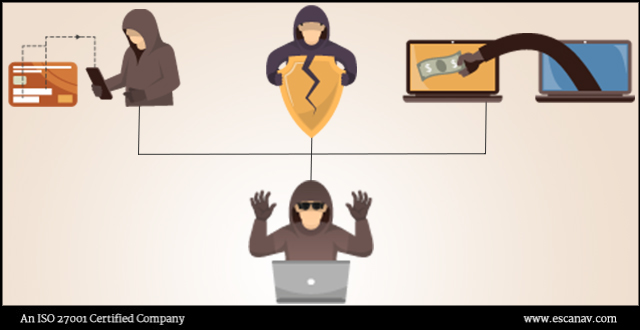Regardless of the massive growth worldwide, security is still a loophole in our day-to-day life. Cybersecurity or IT security is the protection of systems from theft or damage to the hardware, the software, and also to the sensitive information on them. It includes preventing physical access to the hardware, protecting it against the harm that may come via network access, data, and code injection.
Viruses and their effects
According to the reports, there were malware, exploits, PUAs, ransomware, crypto mining malware, and adware was detected on a daily basis worldwide. There was an upward trend in terms of cybercrimes globally in 2018. After two years of rapid growth, ransomware has been ousted as number one payload used in malware campaigns. Ransomware continues to be the popular form of cyber-attack experienced by SMBs. The reports looked at the problem of ransomware attacks from the perspective of Managed Service Providers (MSPs) and their SMB clients. From the past 12 months, that is, in the year 2018, there is a fall in ransomware attacks while there is a rise in crytominers infections. There is a fall in ransomware attacks due to overexposure and increased awareness.
Banking trojans are the most popular malware payload in email attacks. It leads to the stealing of sensitive information of the people to harm the business or individuals. These attacks were on rising trend in the first half of the year 2018 and later on it was on declining trend. Victims of a DDoS attack consist of SMB and Enterprise community which is mostly financial services, IT services, cloud-hosting services, and Telecommunications providers. In Q1 of 2018, GitHub’s code hosting website hit with the largest DDoS attack that peaked at record 1.35 Tbps. Most numbers of DDoS attacks were detected in the first six months of 2018 compared to the same period of last year.
There will be a declining trend in the number of ransomware attacks as criminals are finding crypto jacking, and other measures are effective ways of money making. There are a large number of crypto mining tools available which means attackers need not be technically wise or skilled.
Adoption of IoT Platforms along with AI, ML
The Internet of Things (IoT) is becoming a popular target for hackers/criminals attacks due to the rapid growth of IoT devices have surpassed security. IoT devices have the potential to transport a large amount of personal information about individuals and businesses, making hackers possible to attack. Mostly, the home and SMB community are targeted for this attack.
In 2018, enterprises looked for more holistic approaches to endpoint security in order to organize security processes, to reduce the number of endpoint protection tools, and to provide better protection for all devices that connect to the network. There have been several emerging area of technology trends in 2018 and beyond. The AI-based algorithm has been general in top apps and services across the industries while many organizations are still trying to adapt the machine learning to improve the company’s production. In 2018, the growing demands for systems to be intelligent and alert to potential risk. The usage of AI has boosted the productivity of building systems that are secure and smart.
The IoT is creating smart and safer cities, homes, and businesses by allowing both private and public organizations to securely and remotely monitor facilities. In addition to growing network connectivity beyond computers and smartphones, the IoT is growing in adoption in all the areas. IoT is secure since the organization has internet-connected devices built on a different platform, OS, and different programming languages. There are about 20 billion IoT devices worldwide which prove the IoT is the biggest game changer and trend in 2018. Evans Data states 92% of IoT developers say security is going to be more of an issue in the future. As the trend continues, there will be 26 times more intelligent things connected than people in near future. Some organization is using machine learning to boost the value of their IoT initiatives. Machine learning can be used for the analysis itself. The technology can provide predictions, recommendations of prescriptive actions for enterprise IoT deployments. To overcome the security challenges that IoT devices bring, most of the experts believe machine learning and other new technologies are essential to conclude and recognize threats present in the IT infrastructure.
Cloud Computing
Cloud technology has transformed many businesses in the past decade with its scalability, versatility, and reliability. Of enterprises in 2017 between most organization use cloud services for core back-office functions such as finance and accounting, human resources, and procurement. Machine learning is moving into cloud technology and has become so user-friendly, that developers can integrate it into cloud-hosted applications. Cloud computing will help you to improve security, cost-savings, and cloud monitoring services. Hence, businesses (SMB or corporate) will continue to develop, secure, and integrate services on the cloud network. The race to establish quantum supremacy is on. There is a race to build the first quantum computer that can deliver on the technology’s abilities like smooth data encryption, solving complex medical problems, weather prediction, real conversations with AI and better financial modeling. Also, organizations making a full transition to the cloud might be a challenge and risky. Therefore, organizations use hybrid cloud computing where it can move with its own pace, less risk and cost. Mostly by 2025, almost all organizations will migrate from on-premise data centers towards allocation, hosting, and the cloud. Alongside the big cloud computing and storage providers, there will be an increase in the number of vendors providing cloud services, businesses utilizing cloud services for particular workloads that usually require the use of applications.
Security Issues
The security problem has emerged as one of the biggest problems for the cryptocurrencies including bitcoins, ethereum, NEM, and so on. From theft, hacking to illegal mining, cryptocurrencies are yet to undertake the critical security concerns. There were several cryptocurrency thefts worldwide. Darknet markets allow the selling of various items and services which include stolen data, drugs, fake items, and other services. Darknet market uses the escrow system and accepts Bitcoin, Bitcoin Cash, and Monero as forms of currencies. These websites are accessible through TOR, though other services, such as the Invisible Internet Project and Freenet, are also available. For hackers, money remains a top reason. Other top reasons for hacking include career advancement, the opportunity to protect and defend and to do well in the world. Overall, they want to improve and build their skill sets, have fun and contribute to a safer internet without any breaches. There have been several attacks in 2018 which include the world’s most popular question-and-answer website. Quora has suffered a massive data breach with unknown hackers accessing personal information of about 100 million of its users. Another such example was the world’s biggest hotel chain Marriott confirmed a breach of its Starwood properties that was potentially exposed personal and financial information from half a billion guests, making it the second largest data breaches in the history leaving behind Yahoo 2016 hacking of nearly 3 billion users.
The main challenges faced by SMBs are targeted attacks, ransomware, and advanced persistent threats top the list even in 2018. According to CISCO, 53% of SMBs have experienced a security breach. SMBs usually face phishing as one of the security issues as the attackers’ phish SMBs to gain their entry into the larger enterprise. IT also faces ransomware attacks by attacking important files and details. Even enterprise or corporate organizations face issues such as data breaches, WiFi interferences, stolen or unguarded devices, ransomware. These attacks are possible due to phishing and social engineering, weak passwords, unpatched software, unrestricted cloud storage, and weak configuration on endpoint systems.
Bitcoins and Blockchain technology
Bitcoin is booming, but Blockchain technology is evolving. Blockchain technology is one of the biggest new developments to hit the IT industries over the last few years. It has been originally developed to power the cryptocurrencies; it also has applications over the wide range of industries. With the increased interest in Blockchain technology, there will be a rapid growth of organization using IoT devices, Blockchain, and services in near future. As mentioned above, organizations have started with a combination of IoT and Blockchain technology at a very basic level to create more secure systems. The real-time data from an IoT device can be used in various transactions while protecting the sensitive information of all parties in the network. In upcoming years increased interest in Blockchain technology will make the convergence of Blockchain and IoT devices and services to the next step for manufacturers and vendors. Due to this many will compete for labels like “Blockchain Certified”. Blockchain provides better security by replacing a central database with a distributed ledger of domains and related public keys. It is being used in public key framework such as cryptography is used to secure emails, websites, and other applications. Blockchain and AI will make sure that there will be a smooth integration in the near future. Blockchain along with AI developers is used to develop a secure environment for the big data owners. However, the combination of blockchain technology along with AI will provide security, decentralized control and data sharing, open market for data, the mechanism to handle a large amount of data, and controlling the usage of data and models. Blockchain will become the implementer of the ‘zero trusts’ policy, would hold the key in cybersecurity. In the automation world, organizations expect automated services that are managed from the cloud in a hybrid IT environment.
For more updates on the eScan blog, click here.







